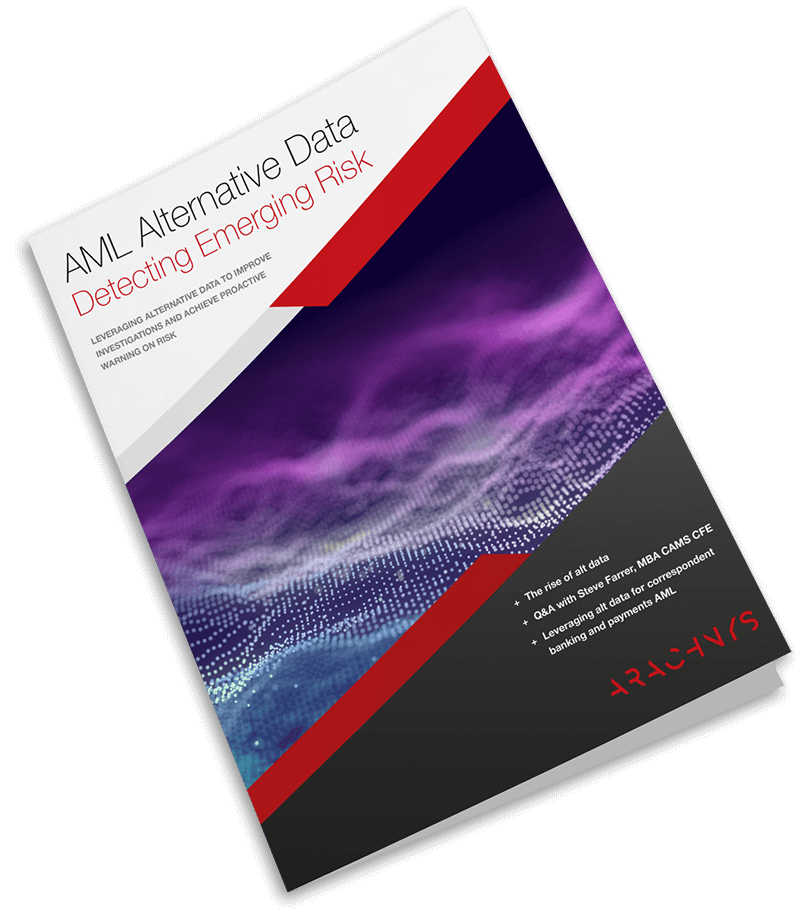2 min read
Alternative data in AML: achieving proactive warning on risk
![]() AML RightSource
:
November 16, 2020
AML RightSource
:
November 16, 2020

In the coming years binary list services, the port of call for entity screening in AML processes, may become more obsolete as alternative data sets will start to augment, or even replace, these traditional methods.
Alternative data can come in many shapes and forms including flight trackers, land registries, social media, shipping data and even satellite imagery. Within the financial world, we are already seeing these non-traditional data sources being used by hedge funds to predict changes in the market for investment decisions and to tackle regulatory problems through proactive risk detection.
It is not just hedge funds looking to adopt the use of alternative data however; fintechs, challenger banks and progressive financial companies are looking to these data sets to assist with KYC and automated AML as both an investigative measure and an ongoing monitoring process.
Practical usage of alternative data
To delve into the real-world, practical usages of alternative data, we had the pleasure of talking to Steve Farrer, an AML expert who has a multitude of experience in identifying and mitigating illicit proceeds from human trafficking within the financial services industry.
Steve outlines that most major institutions use alternative data as a core component for more proactive warning on risk, with daily media monitoring as an invaluable tool, as well as the use of corporate registries, Open Source Intelligence resources, and even social media accounts for spotting the flow of illicit products. Case studies pertaining to social media look into wildlife trafficking and corruption through questionable sources of wealth.
Elsewhere, Steve identifies that satellite and tracking data sources are used beyond government agencies to stop human trafficking. Certain issues such as global vessel and aircraft tracking can best be seen from space using this alternative data-gathering method, which is invaluable to identity forced labour occurrences and the networks which support and profit from this trade.
For correspondent banking and payments AML
There has been a growing need for conducting Know Your Customers’ Customer (KYCC) in light of recent scandals such as Wirecard, which highlighted banks’ exposure to risk through Payment Service Providers (PSPs) and their customers too.
In this recent case, Wirecard’s ‘legitimate’ business instead leaned heavily on adult entertainment providers, hence why better due diligence is needed for these companies. This can be achieved through the automation of both traditional and alternative data sets to detect risks that may go undetected (i.e. shell companies, ‘real’ web presences, whether they are involved in high-risk industries, or dubious related parties).
Pairing alternative data sources with analytics can screen huge numbers of counterparties in a short time, with automated monitoring keeping risk portfolios up to date to avoid business and reputational risk.
Shades of gray
For current AML processes, it is the norm for entities to be screened against a blacklist, which in many cases has a high rate of false positives. Instead, with greater access to alternative data sources, we predict that black-and-white risk alert systems will move towards a grayscale view of risk. Organization-specific requirements can be met through more niche, targeted usage of data, and a more representative risk picture can be built.
One particular use case that can benefit from this is trade finance. International trade data can be used as a detailed alternative data source to detect AML flags, useful for businesses such as correspondent banks with a global remit to track activity committed by criminals using trade-based money laundering methods.
Web intelligence and data crawls of social media can build out a view of criminal networks with detailed and connected entities that try to cover their tracks with under- or over- declaration of goods, for instance. Spotting patterns of behaviour and aggregating various data sources through technology can help analysts for QA and investigative processes.
Download the white paper
 How can financial institutions make the most of alternative data sources to improve KYC and AML processes and achieve proactive warning on risk?
How can financial institutions make the most of alternative data sources to improve KYC and AML processes and achieve proactive warning on risk?
In this white paper we look at the rise of alternative data, being more than just a resource for fund managers and investors, but a core component in fighting financial crime.

